Innovative Use of Single-Use Face Mask Fibers for the Production of a Sustainable Cement Mortar
Abstract
1. Introduction
2. Materials and Methods
2.1. Materials
2.1.1. Treatment of Waste Face Mask
2.1.2. Slashing of Faces Masks
2.1.3. Cement and Aggregate
2.1.4. Mixing and Casting
2.2. Methods
2.2.1. Strength Tests
2.2.2. An Ultrasonic Pulse Velocity (UPV)
- i.
- Each mortar cement specimen has a transmitter and receiver placed at opposing ends of the specimen (Figure 6). Then, ultrasonic pulses of low frequency are produced by this equipment.
- ii.
- The amount of time it took for a signal to move from one transducer to the other via a sample of pulses was measured.
- iii.
- This equation (V (km/s) = path length/transit time) was used to calculate the longitudinal ultrasonic velocities of the samples.
3. Sorptivity Test
4. Results and Discussion
4.1. Workability
4.2. Compressive Strength
4.3. Tensile Strength
4.4. Flexural Strength
4.5. Ultrasonic Pulse Velocity (UPV)
4.6. Sorptivity Test
5. Conclusions
- − Some of the mechanical characteristics of concrete can be improved by adding shredded single-use face masks.
- − The compressive strength of the samples rises by 17% when 1% of the shredded mask fiber has been incorporated in the mortar.
- − When the shredded mask fiber content is added in mortar up to 1.5%, the split tensile strength of the sample specimens increases up to 22%.
- − The flexural strength of the mortar beam has an increment of 30% increase in strength compared to the control specimen when 1% of the shredded mask fiber has been incorporated in the mortar.
- − In comparison to the cement mortar used as a control mix, the impact of shredded mask fiber on working or flow capacity is much lower.
- − As measured by the capillarity test, the mortar’s sorptivity has higher, up to 28%, compared to the control specimen when 2% of the shredded mask fiber is incorporated in the mortar.
- − When comparing the concrete quality made with the control mix, the UPV findings show the mortar mix manufactured using shredded face masks has a significant increment in strength. The fibers from the shredded face masks helped to reduce the number of tiny fractures in the concrete, improving the cement mortar’s quality.
Author Contributions
Funding
Institutional Review Board Statement
Informed Consent Statement
Data Availability Statement
Acknowledgments
Conflicts of Interest
References
- Kilmartin-Lynch, S.; Saberian, M.; Li, J.; Roychand, R.; Zhang, G. Preliminary evaluation of the feasibility of using polypropylene fibres from COVID-19 single-use face masks to improve the mechanical properties of concrete. J. Clean. Prod. 2021, 296, 126460. [Google Scholar] [CrossRef] [PubMed]
- Nzediegwu, C.; Chang, S.X. Improper solid waste management increases potential for COVID-19 spread in developing countries. Resour. Conserv. Recycl. 2020, 161, 104947. [Google Scholar] [CrossRef] [PubMed]
- Sangkham, S. Face mask and medical waste disposal during the novel COVID-19 pandemic in Asia. Case Stud. Chem. Environ. Eng. 2020, 2, 100052. [Google Scholar] [CrossRef]
- Fadare, O.O.; Okoffo, E.D. Since January 2020 Elsevier has created a COVID-19 resource centre with free information in English and Mandarin on the novel coronavirus COVID-19. The COVID-19 resource centre is hosted on Elsevier Connect, the company’ s public news and information. Sci. Total Environ. 2020, 41, 102023. [Google Scholar] [CrossRef]
- Torkashvand, J.; Jonidi Jafari, A.; Godini, K.; Kazemi, Z.; Kazemi, Z.; Farzadkia, M. Municipal solid waste management during COVID-19 pandemic: A comparison between the current activities and guidelines. J. Environ. Health Sci. Eng. 2021, 19, 173–179. [Google Scholar] [CrossRef]
- Neto, H.G.; Bantel, C.G.; Browning, J.; Della Fina, N.; Ballabio, T.A.; de Santana, F.T.; e Britto, M.D.K.; Barbosa, C.B. Mortality of a juvenile Magellanic penguin (Spheniscus magellanicus, Spheniscidae) associated with the ingestion of a PFF-2 protective mask during the Covid-19 pandemic. Mar. Pollut. Bull. 2021, 166, 112232. [Google Scholar] [CrossRef] [PubMed]
- Chowdhury, H.; Chowdhury, T.; Sait, S.M. Estimating marine plastic pollution from COVID-19 face masks in coastal regions. Mar. Pollut. Bull. 2021, 168, 112419. [Google Scholar] [CrossRef]
- Torres-Agullo, A.; Karanasiou, A.; Moreno, T.; Lacorte, S. Overview on the occurrence of microplastics in air and implications from the use of face masks during the COVID-19 pandemic. Sci. Total Environ. 2021, 800, 149555. [Google Scholar] [CrossRef]
- Fadare, O.O.; Okoffo, E.D. Covid-19 face masks: A potential source of microplastic fibers in the environment. Sci. Total Environ. 2020, 737, 140279. [Google Scholar] [CrossRef]
- Abbasi, S.A.; Khalil, A.B.; Arslan, M. Extensive use of face masks during COVID-19 pandemic: (micro-)plastic pollution and potential health concerns in the Arabian Peninsula. Saudi J. Biol. Sci. 2020, 27, 3181–3186. [Google Scholar] [CrossRef]
- Ma, J.; Chen, F.; Xu, H.; Jiang, H.; Liu, J.; Li, P.; Chen, C.C.; Pan, K. Face masks as a source of nanoplastics and microplastics in the environment: Quantification, characterization, and potential for bioaccumulation. Environ. Pollut. 2021, 288, 117748. [Google Scholar] [CrossRef] [PubMed]
- Aragaw, T.A. Surgical face masks as a potential source for microplastic pollution in the COVID-19 scenario. Mar. Pollut. Bull. 2020, 159, 111517. [Google Scholar] [CrossRef] [PubMed]
- Singh, N.; Tang, Y.; Ogunseitan, O.A. Environmentally Sustainable Management of Used Personal Protective Equipment. Environ. Sci. Technol. 2020, 54, 8500–8502. [Google Scholar] [CrossRef]
- Lee, A.W.L.; Neo, E.R.K.; Khoo, Z.-Y.; Yeo, Z.; Tan, Y.S.; Chng, S.; Yan, W.; Lok, B.K.; Low, J.S.C. Life cycle assessment of single-use surgical and embedded filtration layer (EFL) reusable face mask. Resour. Conserv. Recycl. 2021, 170, 105580. [Google Scholar] [CrossRef]
- Ray, S.S.; Lee, H.K.; Huyen, D.T.T.; Chen, S.-S.; Kwon, Y.-N. Microplastics waste in environment: A perspective on recycling issues from PPE kits and face masks during the COVID-19 pandemic. Environ. Technol. Innov. 2022, 26, 102290. [Google Scholar] [CrossRef]
- Torres, F.G.; De-la-Torre, G.E. Face mask waste generation and management during the COVID-19 pandemic: An overview and the Peruvian case. Sci. Total Environ. 2021, 786, 147628. [Google Scholar] [CrossRef]
- Xu, E.G.; Ren, Z.J. Preventing masks from becoming the next plastic problem. Front. Environ. Sci. Eng. 2021, 15, 125. [Google Scholar] [CrossRef] [PubMed]
- Haque, M.S.; Uddin, S.; Sayem, S.M.; Mohib, K.M. Coronavirus disease 2019 (COVID-19) induced waste scenario: A short overview. J. Environ. Chem. Eng. 2021, 9, 104660. [Google Scholar] [CrossRef]
- Sindhunata, J.S.J.; van Deventer, G.C.; Lukey, H.X. Effect of Curing Temperature and Silicate Concentration on Fly-Ash-Based Geopolymerization. Traffic 2006, 45, 3559–3568. [Google Scholar] [CrossRef]
- Bennet, D.; Harris, A.F.; Lacombe, J.; Brooks, C.; Bionda, N.; Strickland, A.D.; Eisenhut, T.; Zenhausern, F. Evaluation of supercritical CO2 sterilization efficacy for sanitizing personal protective equipment from the coronavirus SARS-CoV-2. Sci. Total Environ. 2021, 780, 146519. [Google Scholar] [CrossRef]
- Sookaromdee, P.; Wiwanitkit, V. Surgical face masks and n95 respirators: Is reuse after decontamination treatment justified? Med. J. Dr. D.Y. Patil Univ. 2021, 14, 362. [Google Scholar] [CrossRef]
- Holdsworth, J.; Preston, A.; Gentile, P.; Rider, P.; Yallew, W.; Juno, Z. Process for disinfection of N95 respirators during COVID-19 utilizing sterile processing department: A single center acute care hospital. Am. J. Infect. Control 2021, 49, 489–491. [Google Scholar] [CrossRef] [PubMed]
- Hamzavi, I.H.; Lyons, A.B.; Kohli, I.; Narla, S.; Parks-Miller, A.; Gelfand, J.M.; Lim, H.W.; Ozog, D.M. Ultraviolet germicidal irradiation: Possible method for respirator disinfection to facilitate reuse during the COVID-19 pandemic. J. Am. Acad. Dermatol. 2020, 82, 1511–1512. [Google Scholar] [CrossRef] [PubMed]
- Ibáñez-Cervantes, G.; Bravata-Alcántara, J.C.; Nájera-Cortés, A.S.; Meneses-Cruz, S.; Delgado-Balbuena, L.; Cruz-Cruz, C.; Durán-Manuel, E.M.; Cureño-Díaz, M.A.; Gómez-Zamora, E.; Chávez-Ocaña, S.; et al. Disinfection of N95 masks artificially contaminated with SARS-CoV-2 and ESKAPE bacteria using hydrogen peroxide plasma: Impact on the reutilization of disposable devices. Am. J. Infect. Control 2020, 48, 1037–1041. [Google Scholar] [CrossRef]
- Richter, A.; Ng, K.T.W.; Vu, H.L.; Kabir, G. Waste disposal characteristics and data variability in a mid-sized Canadian city during COVID-19. Waste Manag. 2021, 122, 49–54. [Google Scholar] [CrossRef] [PubMed]
- Bleck, D.; Wettberg, W. Waste collection in developing countries—Tackling occupational safety and health hazards at their source. Waste Manag. 2012, 32, 2009–2017. [Google Scholar] [CrossRef]
- Kalina, M.; Tilley, E. “This is our next problem”: Cleaning up from the COVID-19 response. Waste Manag. 2020, 108, 202–205. [Google Scholar] [CrossRef]
- Chen, R.; Zhang, D.; Xu, X.; Yuan, Y. Pyrolysis characteristics, kinetics, thermodynamics and volatile products of waste medical surgical mask rope by thermogravimetry and online thermogravimetry-Fourier transform infrared-mass spectrometry analysis. Fuel 2021, 295, 120632. [Google Scholar] [CrossRef]
- Selvaranjan, K.; Navaratnam, S.; Rajeev, P.; Ravintherakumaran, N. Environmental challenges induced by extensive use of face masks during COVID-19: A review and potential solutions. Environ. Chall. 2021, 3, 100039. [Google Scholar] [CrossRef]
- Parija, S.; Mishra, D.; Leung, C. Preliminary Results of Concrete with Shredded Disposable Face Masks. In Proceedings of the 35th Indian Engineering Congress (IEC)—Engineering for Self Reliance and Sutainable Goals, Kolkata, India, 18–20 December 2020. [Google Scholar]
- ur Rehman, Z.; Khalid, U. Reuse of COVID-19 face mask for the amelioration of mechanical properties of fat clay: A novel solution to an emerging waste problem. Sci. Total Environ. 2021, 794, 148746. [Google Scholar] [CrossRef]
- Chakrawarthi, V.; Dharmar, B.; Avudaiappan, S.; Amran, M.; Flores, E.S.; Alam, M.A.; Fediuk, R.; Vatin, N.I.; Rashid, R.S.M. Destructive and Non-Destructive Testing of the Performance of Copper Slag Fiber-Reinforced Concrete. Materials 2022, 15, 4536. [Google Scholar] [CrossRef] [PubMed]
- Joseph, H.S.; Pachiappan, T.; Avudaiappan, S.; Maureira-Carsalade, N.; Roco-Videla, Á.; Guindos, P.; Parra, P.F. A Comprehensive Review on Recycling of Construction Demolition Waste in Concrete. Sustainability 2023, 15, 4932. [Google Scholar] [CrossRef]
- Birniwa, A.H.; Abdullahi, S.S.; Ali, M.; Mohammad, R.E.; Jagaba, A.H.; Amran, M.; Avudaiappan, S.; Maureira-Carsalade, N.; Flores, E.I.S. Recent Trends in Treatment and Fabrication of Plant-Based Fiber-Reinforced Epoxy Composite: A Review. J. Compos. Sci. 2023, 7, 120. [Google Scholar] [CrossRef]
- Awoyera, P.O.; Olalusi, O.B.; Ibia, S.; Prakash, A.K. Water absorption, strength and microscale properties of interlocking concrete blocks made with plastic fibre and ceramic aggregates. Case Stud. Constr. Mater. 2021, 15, e00677. [Google Scholar] [CrossRef]
- Yin, S.; Tuladhar, R.; Shi, F.; Combe, M.; Collister, T.; Sivakugan, N. Use of macro plastic fibres in concrete: A review. Constr. Build. Mater. 2015, 93, 180–188. [Google Scholar] [CrossRef]
- Puertas, F.; Amat, T.; Fernández-Jiménez, A.; Vázquez, T. Mechanical and durable behaviour of alkaline cement mortars reinforced with polypropylene fibres. Cem. Concr. Res. 2003, 33, 2031–2036. [Google Scholar] [CrossRef]
- Toutanji, H.A. Properties of polypropylene fiber reinforced silica fume expansive-cement concrete. Constr. Build. Mater. 1999, 13, 171–177. [Google Scholar] [CrossRef]
- Elkatatny, S.; Gajbhiye, R.; Ahmed, A.; Mahmoud, A.A. Enhancing the cement quality using polypropylene fiber. J. Pet. Explor. Prod. Technol. 2020, 10, 1097–1107. [Google Scholar] [CrossRef]
- Akbar, A.; Farooq, F.; Shafique, M.; Aslam, F.; Alyousef, R.; Alabduljabbar, H. Sugarcane bagasse ash-based engineered geopolymer mortar incorporating propylene fibers. J. Build. Eng. 2021, 33, 101492. [Google Scholar] [CrossRef]
- Idrees, M. Comparative study of hybrid fiber cementitious composites. Indep. J. Manag. Prod. 2020, 11, 1034. [Google Scholar] [CrossRef]
- Prakash, A.K.; Helena, H.J.; Oluwaseun Awoyera, P. Optimization of Mix Proportions for Novel Dry Stack Interlocking Concrete Blocks Using ANN. Adv. Civ. Eng. 2021, 2021, 9952781. [Google Scholar] [CrossRef]
- Islam, G.S.; Gupta, S.D. Das Evaluating plastic shrinkage and permeability of polypropylene fiber reinforced concrete. Int. J. Sustain. Built Environ. 2016, 5, 345–354. [Google Scholar] [CrossRef]
- Jayanthi, V.; Avudaiappan, S.; Amran, M.; Arunachalam, K.P.; Qader, D.N.; Delgado, M.C.; Flores, E.I.S.; Rashid, R.S.M. Innovative use of micronized biomass silica-GGBS as agro-industrial by-products for the production of a sustainable high-strength geopolymer concrete. Case Stud. Constr. Mater. 2023, 18, e01782. [Google Scholar] [CrossRef]
- Kavitha, S.A.; Priya, R.K.; Arunachalam, K.P.; Avudaiappan, S.; Maureira-Carsalade, N.; Roco-Videla, Á. Investigation on Properties of Raw and Alkali Treated Novel Cellulosic Root Fibres of Zea Mays for Polymeric Composites. Polymers 2023, 15, 1802. [Google Scholar] [CrossRef] [PubMed]
- Xu, H.; Shao, Z.; Wang, Z.; Cai, L.; Li, Z.; Jin, H.; Chen, T. Experimental study on mechanical properties of fiber reinforced concrete: Effect of cellulose fiber, polyvinyl alcohol fiber and polyolefin fiber. Constr. Build. Mater. 2020, 261, 120610. [Google Scholar] [CrossRef]
- Pešić, N.; Živanović, S.; Garcia, R.; Papastergiou, P. Mechanical properties of concrete reinforced with recycled HDPE plastic fibres. Constr. Build. Mater. 2016, 115, 362–370. [Google Scholar] [CrossRef]
- Mohajerani, A.; Hui, S.-Q.; Mirzababaei, M.; Arulrajah, A.; Horpibulsuk, S.; Abdul Kadir, A.; Rahman, M.T.; Maghool, F. Amazing Types, Properties, and Applications of Fibres in Construction Materials. Materials 2019, 12, 2513. [Google Scholar] [CrossRef]
- Behfarnia, K.; Behravan, A. Application of high performance polypropylene fibers in concrete lining of water tunnels. Mater. Des. 2014, 55, 274–279. [Google Scholar] [CrossRef]
- Al-Hadithi, A.I.; Hilal, N.N. The possibility of enhancing some properties of self-compacting concrete by adding waste plastic fibers. J. Build. Eng. 2016, 8, 20–28. [Google Scholar] [CrossRef]
- Latifi, M.R.; Biricik, Ö.; Aghabaglou, A.M. Effect of the addition of polypropylene fiber on concrete properties. J. Adhes. Sci. Technol. 2022, 36, 345–369. [Google Scholar] [CrossRef]
- Akbar, A.; Liew, K.M. Multicriteria performance evaluation of fiber-reinforced cement composites: An environmental perspective. Compos. Part B Eng. 2021, 218, 108937. [Google Scholar] [CrossRef]
- Nguyen, H.; Kinnunen, P.; Carvelli, V.; Illikainen, M. Durability of ettringite-based composite reinforced with polypropylene fibers under combined chemical and physical attack. Cem. Concr. Compos. 2019, 102, 157–168. [Google Scholar] [CrossRef]
- Abisha, M.; Priya, R.K.; Arunachalam, K.P.; Avudaiappan, S.; Saavedra Flores, E.I.; Parra, P.F. Biodegradable Green Composites: Effects of Potassium Permanganate (KMnO4) Treatment on Thermal, Mechanical, and Morphological Behavior of Butea Parviflora (BP) Fibers. Polymers 2023, 15, 2197. [Google Scholar] [CrossRef]
- Sharma, R.; Bansal, P.P. Use of different forms of waste plastic in concrete—A review. J. Clean. Prod. 2016, 112, 473–482. [Google Scholar] [CrossRef]
- Abd El Aal, A.; Abdullah, G.M.; Qadri, S.T.; Abotalib, A.Z.; Othman, A. Advances on concrete strength properties after adding polypropylene fibers from health personal protective equipment (PPE) of COVID-19: Implication on waste management and sustainable environment. Phys. Chem. Earth 2022, 128, 103260. [Google Scholar] [CrossRef]
- Koniorczyk, M.; Bednarska, D.; Masek, A.; Cichosz, S. Performance of concrete containing recycled masks used for personal protection during coronavirus pandemic. Constr. Build. Mater. 2022, 324, 126712. [Google Scholar] [CrossRef] [PubMed]
- Ahmed, W.; Lim, C.W. Effective recycling of disposable medical face masks for sustainable green concrete via a new fiber hybridization technique. Constr. Build. Mater. 2022, 344, 128245. [Google Scholar] [CrossRef]
- Miah, J.; Pei, J.; Kim, H.; Sharma, R.; Gook, J.; Ahn, J. Property assessment of an eco-friendly mortar reinforced with recycled mask fiber derived from COVID-19 single-use face masks. J. Build. Eng. 2023, 66, 105885. [Google Scholar] [CrossRef]
- Suman, R.; Javaid, M.; Haleem, A.; Vaishya, R.; Bahl, S.; Nandan, D. Sustainability of Coronavirus on Different Surfaces. J. Clin. Exp. Hepatol. 2020, 10, 386–390. [Google Scholar] [CrossRef]
- Audi, A.; AlIbrahim, M.; Kaddoura, M.; Hijazi, G.; Yassine, H.M.; Zaraket, H. Seasonality of Respiratory Viral Infections: Will COVID-19 Follow Suit? Front. Public Health 2020, 8, 567184. [Google Scholar] [CrossRef]
- Mohan, H.T.; Jayanarayanan, K.; Mini, K.M. A sustainable approach for the utilization of PPE biomedical waste in the construction sector. Eng. Sci. Technol. Int. J. 2022, 32, 101060. [Google Scholar] [CrossRef]
- ASTM C150/C150M Astm C 150; Standard Specification for Portland Cement. ASTM: West Conshohocken, PA, USA, 2012. [CrossRef]
- ASTM C 33-99a; Standard Spesification for Concrete Aggregates. American Society for Testing and Materials: West Conshohocken, PA, USA, 2010; pp. 1–11.
- ACI-211.1-91; Standard Practice for Selecting Proportions for Normal, Heavyweight, and Mass Concrete. ASTM: West Conshohocken, PA, USA, 1991.
- ASTM C109/C109M-02; Standard Test Method for Compressive Strength of Hydraulic Cement Mortars. ASTM: West Conshohocken, PA, USA, 2020; Volume 4, p. 9.
- ASTM C923/C293M. ASTM Standards C 293-02; Standard Test Method Flexural Strength Cement. ASTM: West Conshohocken, PA, USA, 2002; pp. 1–3.
- Al-Hadithi, A.I.; Noaman, A.T.; Mosleh, W.K. Mechanical properties and impact behavior of PET fiber reinforced self-compacting concrete (SCC). Compos. Struct. 2019, 224, 111021. [Google Scholar] [CrossRef]
- Hama, S.M.; Hilal, N.N. Fresh properties of self-compacting concrete with plastic waste as partial replacement of sand. Int. J. Sustain. Built Environ. 2017, 6, 299–308. [Google Scholar] [CrossRef]
- Mohammed, A.A.; Rahim, A.A.F. Experimental Behavior and Analysis of High Strength Concrete Beams Reinforced with PET Waste Fiber. Constr. Build. Mater. 2020, 244, 118350. [Google Scholar] [CrossRef]
- Khatib, J.M.; Herki, B.A.; Elkordi, A. 7—Characteristics of concrete containing EPS. In Woodhead Publishing Series in Civil and Structural Engineering; Pacheco-Torgal, F., Khatib, J., Colangelo, F., Tuladhar, R.B.T.-U., Eds.; Woodhead Publishing: Sawston, UK, 2019; pp. 137–165. ISBN 978-0-08-102676-2. [Google Scholar]
- Şimşek, B.; Uygunoğlu, T.; Korucu, H.; Kocakerim, M.M. 11—Performance of dioctyl terephthalate concrete. In Woodhead Publishing Series in Civil and Structural Engineering; Pacheco-Torgal, F., Khatib, J., Colangelo, F., Tuladhar, R.B.T.-U., Eds.; Woodhead Publishing: Sawston, UK, 2019; pp. 249–267. ISBN 978-0-08-102676-2. [Google Scholar]
- Yap, S.P.; Alengaram, U.J.; Jumaat, M.Z. Enhancement of mechanical properties in polypropylene– and nylon–fibre reinforced oil palm shell concrete. Mater. Des. 2013, 49, 1034–1041. [Google Scholar] [CrossRef]
- Shen, D.; Liu, X.; Zeng, X.; Zhao, X.; Jiang, G. Effect of polypropylene plastic fibers length on cracking resistance of high performance concrete at early age. Constr. Build. Mater. 2020, 244, 117874. [Google Scholar] [CrossRef]
- Arunachalam, K.P.; Avudaiappan, S.; Flores, E.I.S.; Parra, P.F. Experimental Study on the Mechanical Properties and Microstructures of Cenosphere Concrete. Materials 2023, 16, 3518. [Google Scholar] [CrossRef]


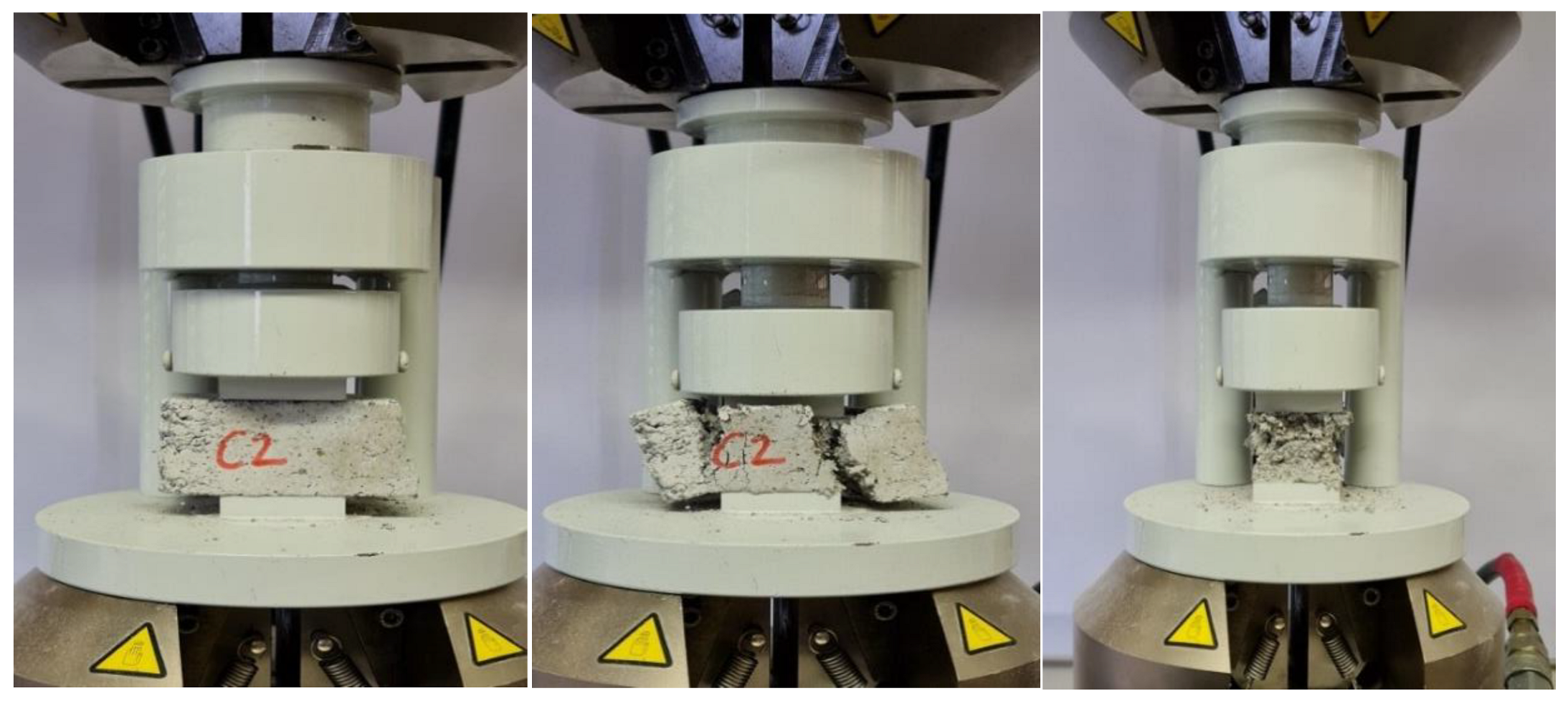
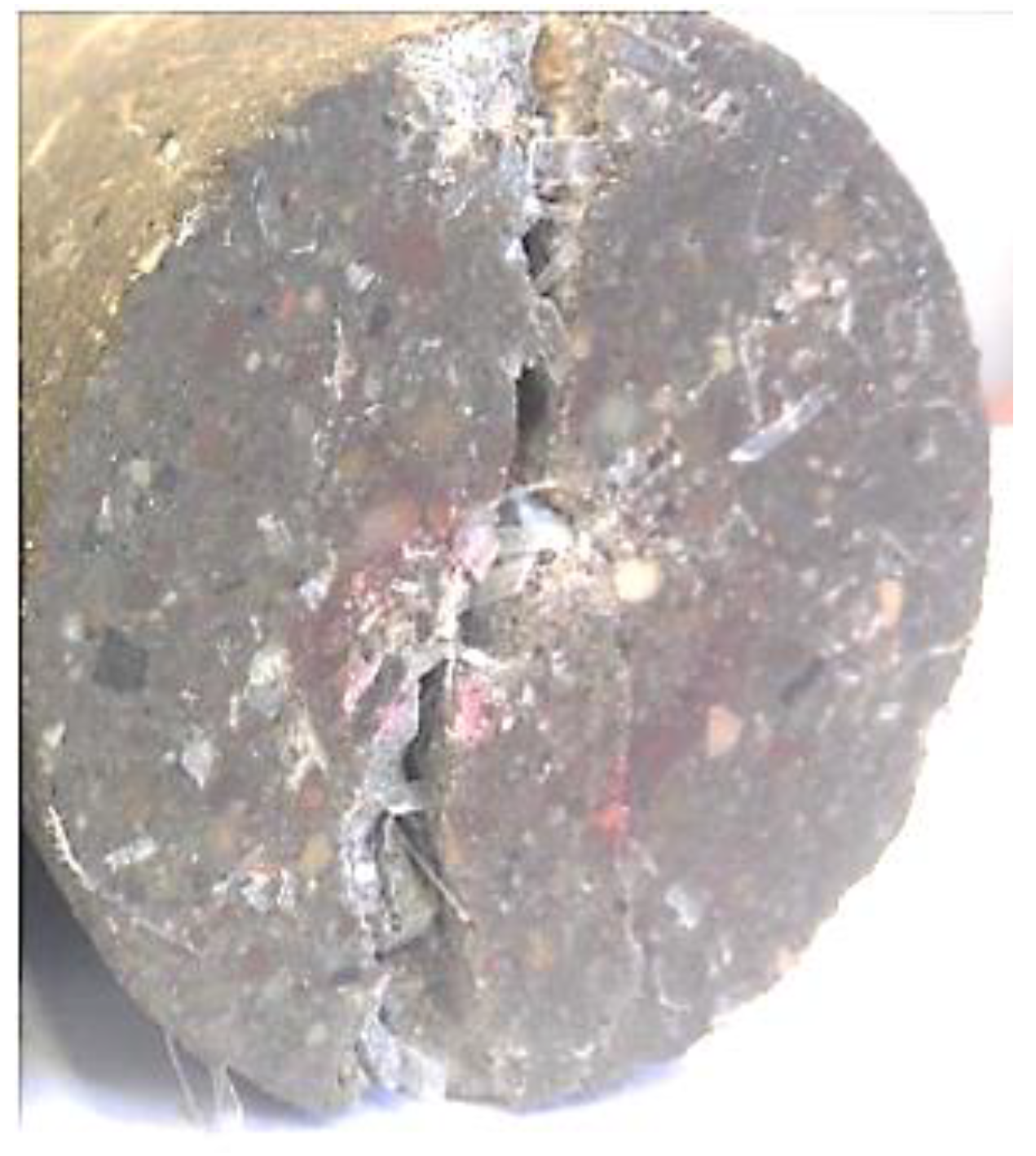
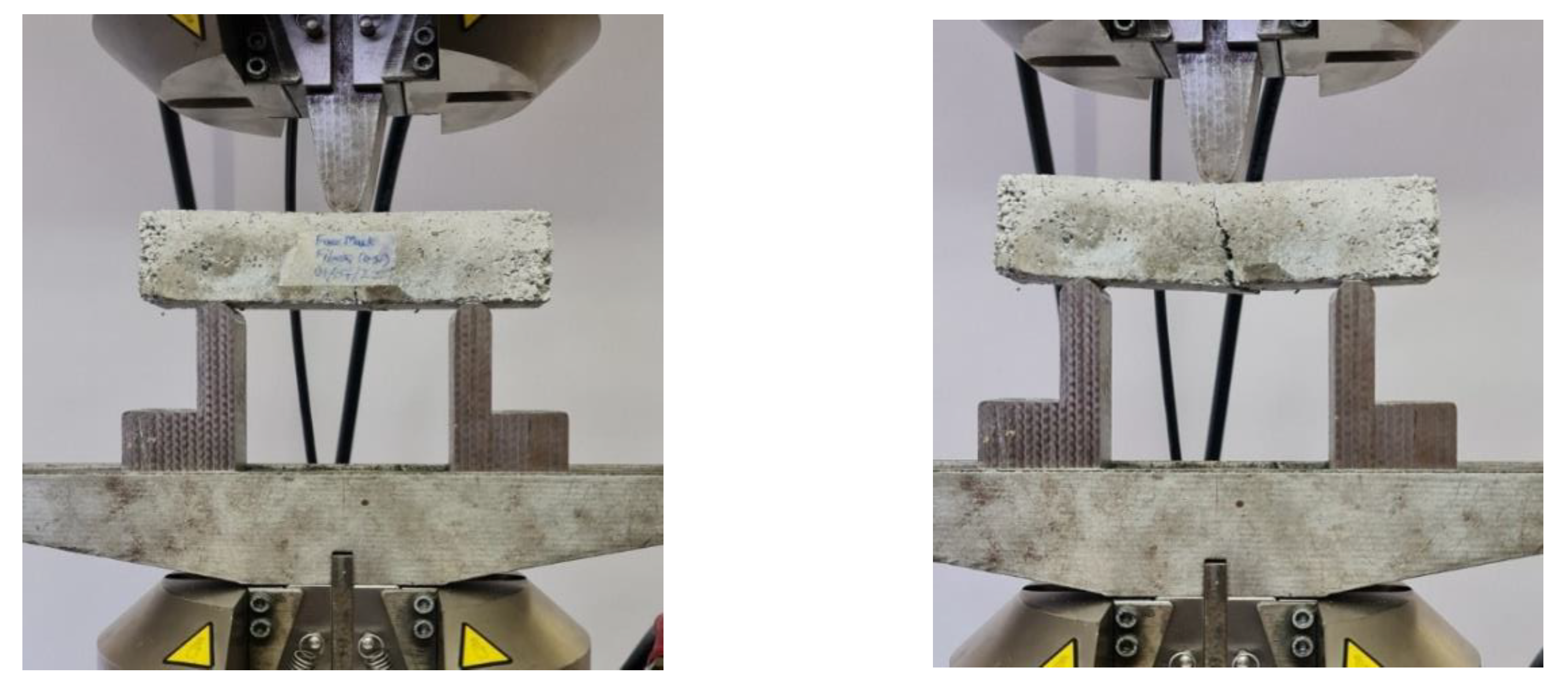
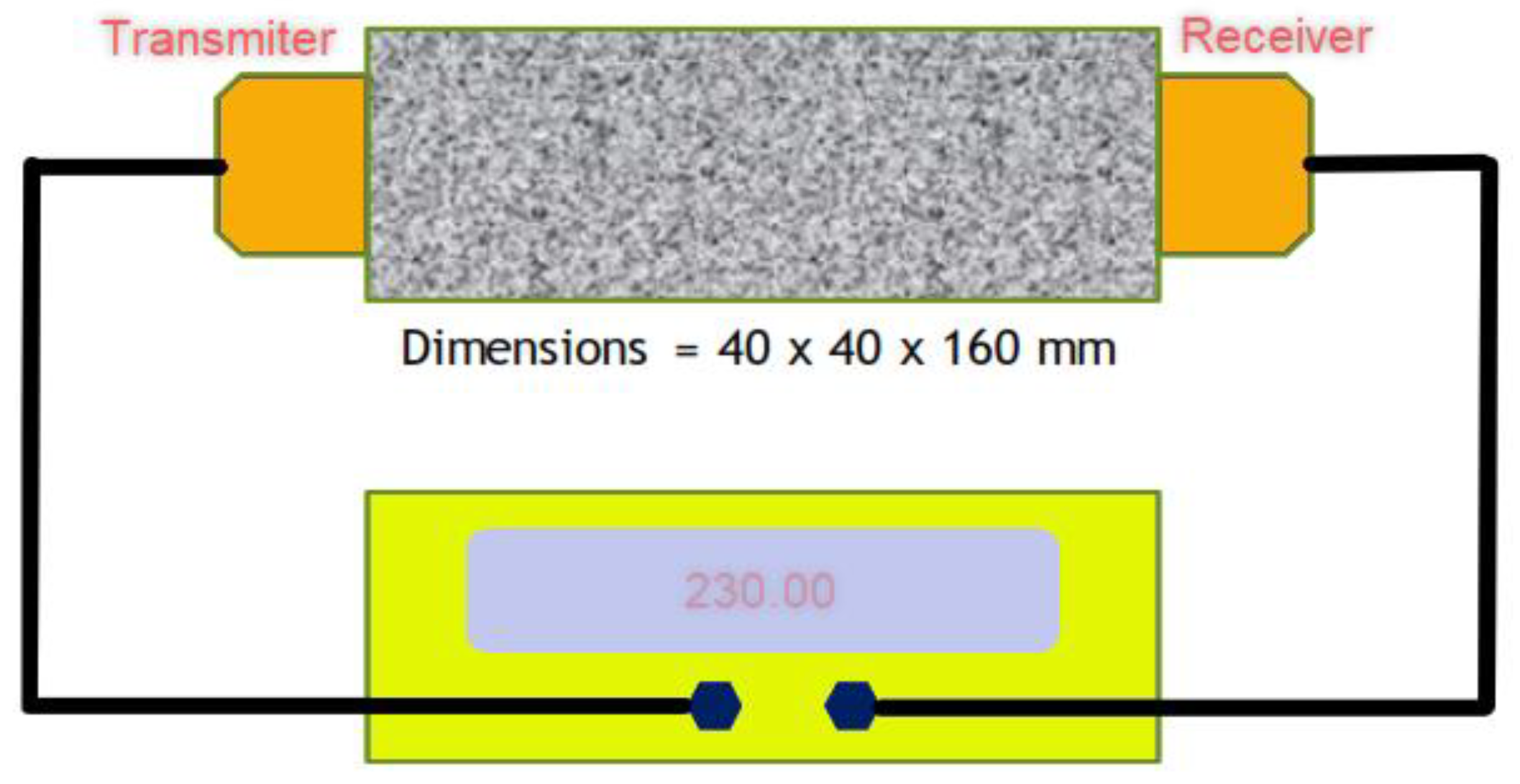
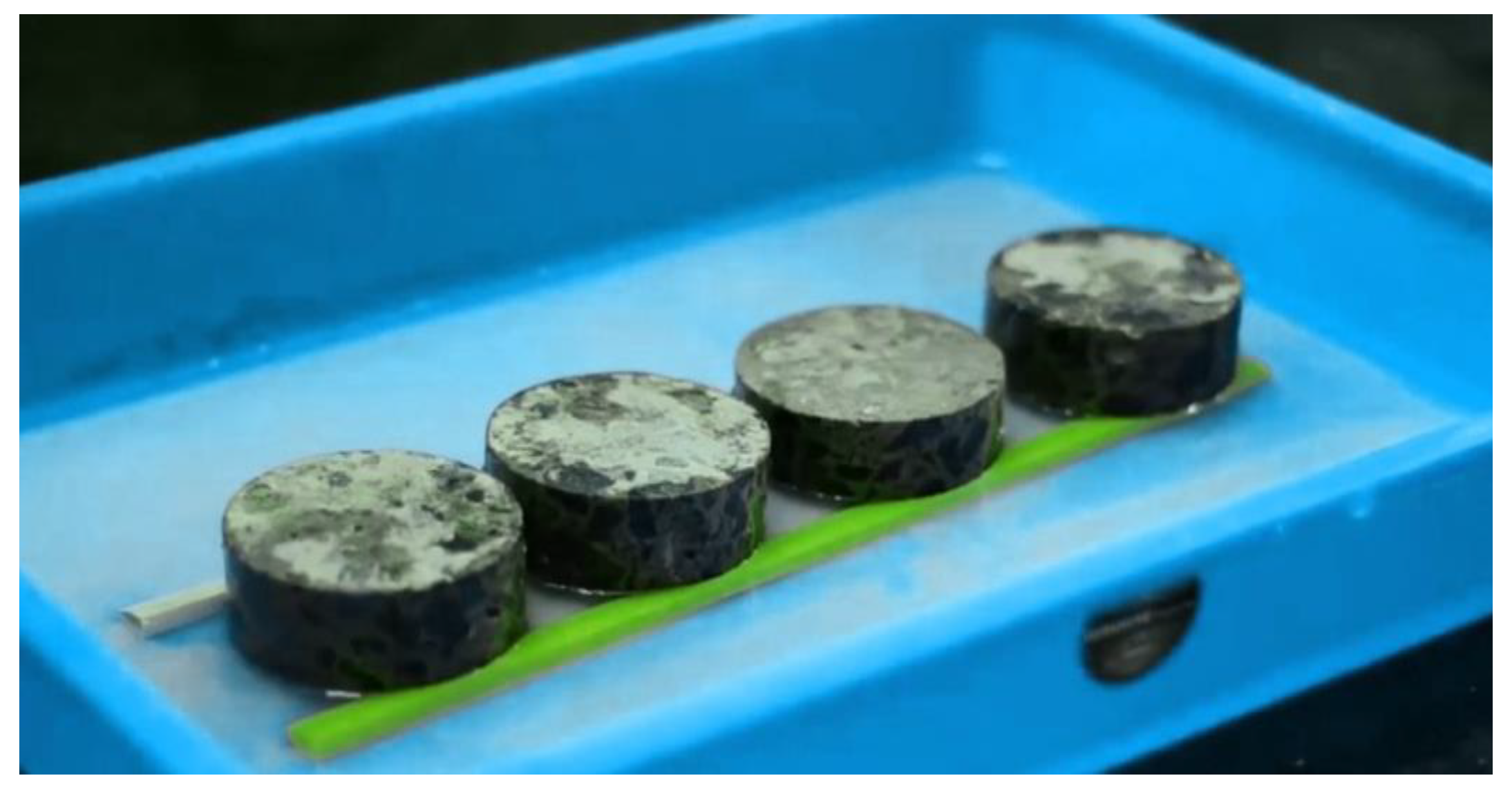
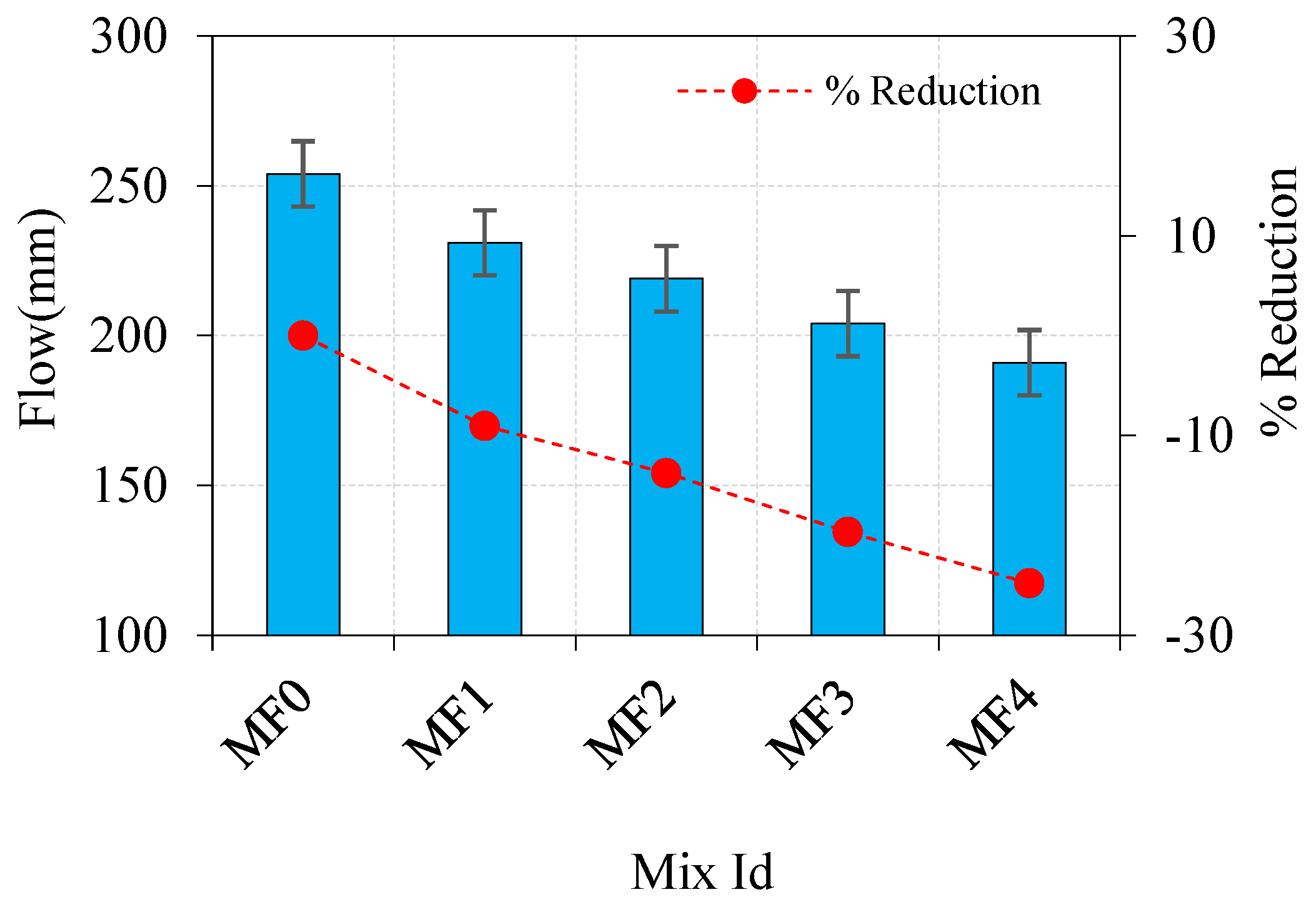



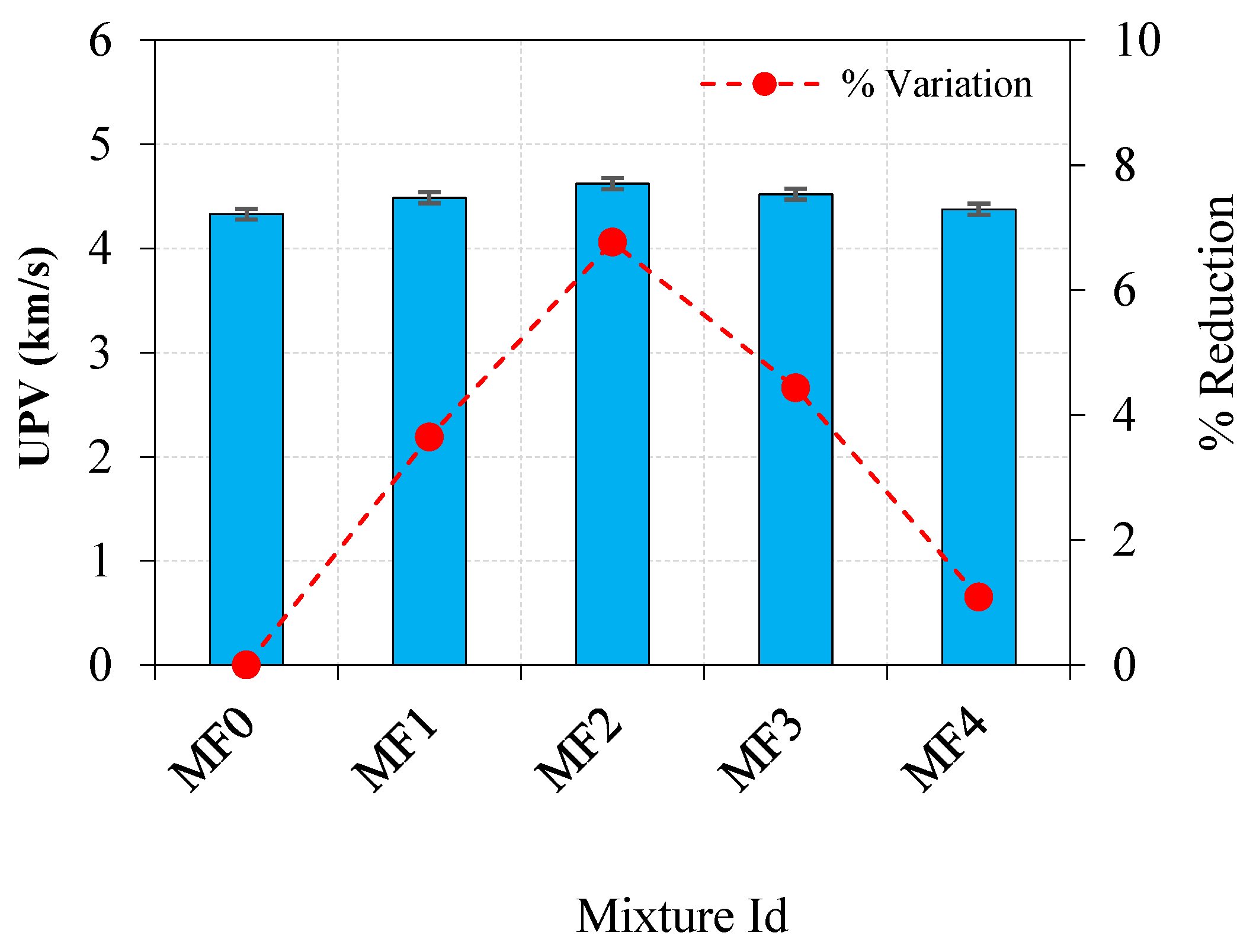

| Mineral Composition | Chemical Composition | |||||||||
|---|---|---|---|---|---|---|---|---|---|---|
| C3S | C2S | C3A | SiO2 | Al2O3 | Fe2O3 | MgO | CaO | K2O | SO3 | Na2O |
| 52 | 22.1 | 8.75 | 20.4 | 6.55 | 3.56 | 1.75 | 65 | 0.54 | 0.42 | 0.25 |
| S.No | Fiber Content % | Cement Weight (kg) | Sand Weight (kg) | Fiber Weight (kg) | Water Weight (kg) | Superplasticizer Weight (kg) | Workability |
|---|---|---|---|---|---|---|---|
| MF0 | 0 | 480 | 960 | 0 | 192 | 4.8 | 254 |
| MF1 | 0.5 | 480 | 960 | 2.4 | 192 | 4.8 | 231 |
| MF2 | 1 | 480 | 960 | 4.8 | 192 | 4.8 | 219 |
| MF3 | 1.5 | 480 | 960 | 7.2 | 192 | 4.8 | 204 |
| MF4 | 2 | 480 | 960 | 9.6 | 192 | 4.8 | 191 |
| Mix. ID | Water Absorption (%) | Sorptivity (mm/√Sec) | UPV m/s |
|---|---|---|---|
| MF0 | 3.560 | 0.0225 | 4329 |
| MF1 | 3.780 | 0.0238 | 4487 |
| MF2 | 3.947 | 0.0256 | 4652 |
| MF3 | 4.162 | 0.0272 | 4521 |
| MF4 | 4.338 | 0.0289 | 4376 |
Disclaimer/Publisher’s Note: The statements, opinions and data contained in all publications are solely those of the individual author(s) and contributor(s) and not of MDPI and/or the editor(s). MDPI and/or the editor(s) disclaim responsibility for any injury to people or property resulting from any ideas, methods, instructions or products referred to in the content. |
© 2023 by the authors. Licensee MDPI, Basel, Switzerland. This article is an open access article distributed under the terms and conditions of the Creative Commons Attribution (CC BY) license (https://creativecommons.org/licenses/by/4.0/).
Share and Cite
Avudaiappan, S.; Cendoya, P.; Arunachalam, K.P.; Maureira-Carsalade, N.; Canales, C.; Amran, M.; Parra, P.F. Innovative Use of Single-Use Face Mask Fibers for the Production of a Sustainable Cement Mortar. J. Compos. Sci. 2023, 7, 214. https://doi.org/10.3390/jcs7060214
Avudaiappan S, Cendoya P, Arunachalam KP, Maureira-Carsalade N, Canales C, Amran M, Parra PF. Innovative Use of Single-Use Face Mask Fibers for the Production of a Sustainable Cement Mortar. Journal of Composites Science. 2023; 7(6):214. https://doi.org/10.3390/jcs7060214
Chicago/Turabian StyleAvudaiappan, Siva, Patricio Cendoya, Krishna Prakash Arunachalam, Nelson Maureira-Carsalade, Cristian Canales, Mugahed Amran, and Pablo F. Parra. 2023. "Innovative Use of Single-Use Face Mask Fibers for the Production of a Sustainable Cement Mortar" Journal of Composites Science 7, no. 6: 214. https://doi.org/10.3390/jcs7060214
APA StyleAvudaiappan, S., Cendoya, P., Arunachalam, K. P., Maureira-Carsalade, N., Canales, C., Amran, M., & Parra, P. F. (2023). Innovative Use of Single-Use Face Mask Fibers for the Production of a Sustainable Cement Mortar. Journal of Composites Science, 7(6), 214. https://doi.org/10.3390/jcs7060214










